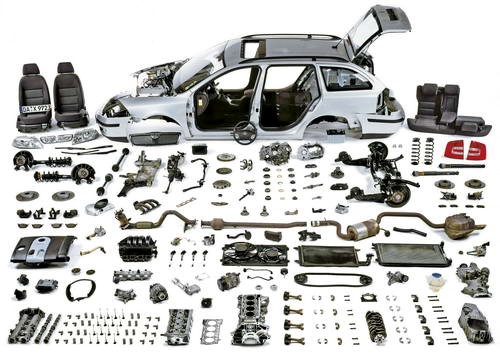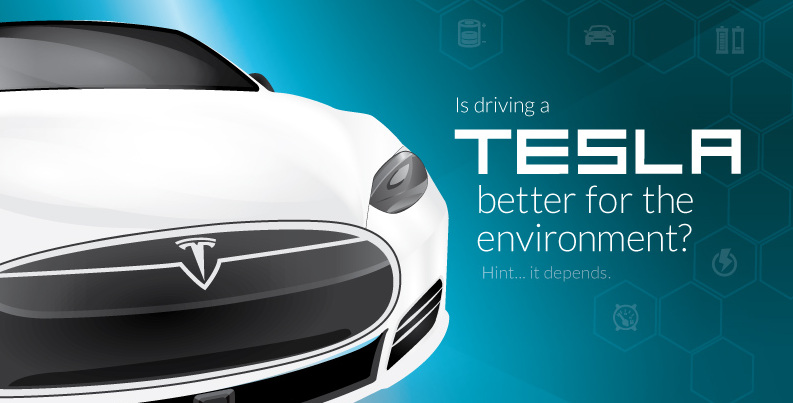Energy
Is Driving a Tesla Better for the Environment? It Depends…
Are Teslas and other electric vehicles perfect for the environment?
The answer is “no”, since nothing can be perfect. Electric vehicles are still a source of GHG emissions as a result of the manufacturing and raw material extraction processes. Further, and more importantly, lifetime emissions for electric vehicles also depend on the sources of fuel used to power the local grid.
So Is Driving a Tesla Better for the Environment?
Today’s infographic, which looks at the well-to-wheels impact of electric and gas vehicles, was created in association with Delbrook Capital, a financial services company that has launched the CO2 Master Solutions Fund.
Together we explore the latest data on the lifetime emissions of gasoline and electric vehicles, and how they compare depending on the state you live in:
Is driving a Tesla better for the environment than using a comparably sized gas-powered vehicle? In the majority of places, the answer is “yes”.
However, the true environmental impact depends greatly on the specific power sources that the local grid uses to generate electricity.
The Power Mix
According to a study done by the Union of Concerned Scientists, the average new gasoline vehicle generates the equivalent of 29 MPG of emissions over its lifetime. The study found that the average electric vehicle has emission equivalents in a range between 35 MPG to 135 MPG depending on the local power grid of the state it is driven in.
Electric cars driven in the Pacific Northwest states, as an example, have the emissions of an equivalent 94 MPG gas-powered car. This is miles better than a new Honda Fit (36 MPG) or even hybrids such as the Prius (50 MPG) or Honda Accord hybrid (47 MPG). This is because 52% of all power in the region comes from hydro.
In Colorado, about 70% of all electricity is coal-fired. This means that the electric car has the equivalent emissions of a gas-powered Honda Fit with 35 MPG. In Florida, natural gas has replaced coal usage, and now accounts for two-thirds of all electricity generated. Powering an EV on Florida’s grid for an estimated 51 MPG equivalent is better than driving a hybrid such as a Prius (50 MPG) or a Honda Accord Hybrid (47 MPG).
The Future of Emissions
Today, the study by the Union of Concerned Scientists concludes that 66% of Americans definitely would generate less emissions by driving electric vehicles based on the compositions of their local power grids.
In the very near future, plugging in will be better in 100% of places in America. Here’s why:
- Battery technology will continue to get better. More efficiency means lighter and better cars.
- Coal is falling. It’s gone from 44% of all U.S. power generation in 2009 to 33% in 2015. It’s forecasted to fall to 22% by 2020.
- Many states also have committed to specific targets for green energy as a portion of their energy mix. More renewables for the grid means less emissions.
For investors, these changes will create many opportunities for investors.
As the electric car era is ushered in, some experts are predicting that entire power grids will need to be re-wired to accommodate. Automobile dealer networks will be profoundly affected.
Car part manufacturers will also have to adapt. How many pieces are in a typical gas-powered vehicle? According to energy expert Gianni Kovacevic there are about 100.

In an electric vehicle, which only needs about 20 components, many of these parts such as pistons and spark plugs will become antiquated.
Energy
Charted: 4 Reasons Why Lithium Could Be the Next Gold Rush
Visual Capitalist has partnered with EnergyX to show why drops in prices and growing demand may make now the right time to invest in lithium.

4 Reasons Why You Should Invest in Lithium
Lithium’s importance in powering EVs makes it a linchpin of the clean energy transition and one of the world’s most precious minerals.
In this graphic, Visual Capitalist partnered with EnergyX to explore why now may be the time to invest in lithium.
1. Lithium Prices Have Dropped
One of the most critical aspects of evaluating an investment is ensuring that the asset’s value is higher than its price would indicate. Lithium is integral to powering EVs, and, prices have fallen fast over the last year:
| Date | LiOH·H₂O* | Li₂CO₃** |
|---|---|---|
| Feb 2023 | $76 | $71 |
| March 2023 | $71 | $61 |
| Apr 2023 | $43 | $33 |
| May 2023 | $43 | $33 |
| June 2023 | $47 | $45 |
| July 2023 | $44 | $40 |
| Aug 2023 | $35 | $35 |
| Sept 2023 | $28 | $27 |
| Oct 2023 | $24 | $23 |
| Nov 2023 | $21 | $21 |
| Dec 2023 | $17 | $16 |
| Jan 2024 | $14 | $15 |
| Feb 2024 | $13 | $14 |
Note: Monthly spot prices were taken as close to the 14th of each month as possible.
*Lithium hydroxide monohydrate MB-LI-0033
**Lithium carbonate MB-LI-0029
2. Lithium-Ion Battery Prices Are Also Falling
The drop in lithium prices is just one reason to invest in the metal. Increasing economies of scale, coupled with low commodity prices, have caused the cost of lithium-ion batteries to drop significantly as well.
In fact, BNEF reports that between 2013 and 2023, the price of a Li-ion battery dropped by 82%.
| Year | Price per KWh |
|---|---|
| 2023 | $139 |
| 2022 | $161 |
| 2021 | $150 |
| 2020 | $160 |
| 2019 | $183 |
| 2018 | $211 |
| 2017 | $258 |
| 2016 | $345 |
| 2015 | $448 |
| 2014 | $692 |
| 2013 | $780 |

3. EV Adoption is Sustainable
One of the best reasons to invest in lithium is that EVs, one of the main drivers behind the demand for lithium, have reached a price point similar to that of traditional vehicle.
According to the Kelly Blue Book, Tesla’s average transaction price dropped by 25% between 2022 and 2023, bringing it in line with many other major manufacturers and showing that EVs are a realistic transport option from a consumer price perspective.
| Manufacturer | September 2022 | September 2023 |
|---|---|---|
| BMW | $69,000 | $72,000 |
| Ford | $54,000 | $56,000 |
| Volkswagon | $54,000 | $56,000 |
| General Motors | $52,000 | $53,000 |
| Tesla | $68,000 | $51,000 |
4. Electricity Demand in Transport is Growing
As EVs become an accessible transport option, there’s an investment opportunity in lithium. But possibly the best reason to invest in lithium is that the IEA reports global demand for the electricity in transport could grow dramatically by 2030:
| Transport Type | 2022 | 2025 | 2030 |
|---|---|---|---|
| Buses 🚌 | 23,000 GWh | 50,000 GWh | 130,000 GWh |
| Cars 🚙 | 65,000 GWh | 200,000 GWh | 570,000 GWh |
| Trucks 🛻 | 4,000 GWh | 15,000 GWh | 94,000 GWh |
| Vans 🚐 | 6,000 GWh | 16,000 GWh | 72,000 GWh |
The Lithium Investment Opportunity
Lithium presents a potentially classic investment opportunity. Lithium and battery prices have dropped significantly, and recently, EVs have reached a price point similar to other vehicles. By 2030, the demand for clean energy, especially in transport, will grow dramatically.
With prices dropping and demand skyrocketing, now is the time to invest in lithium.
EnergyX is poised to exploit lithium demand with cutting-edge lithium extraction technology capable of extracting 300% more lithium than current processes.

-

 Lithium3 days ago
Lithium3 days agoRanked: The Top 10 EV Battery Manufacturers in 2023
Asia dominates this ranking of the world’s largest EV battery manufacturers in 2023.
-

 Energy1 week ago
Energy1 week agoThe World’s Biggest Nuclear Energy Producers
China has grown its nuclear capacity over the last decade, now ranking second on the list of top nuclear energy producers.
-

 Energy4 weeks ago
Energy4 weeks agoThe World’s Biggest Oil Producers in 2023
Just three countries accounted for 40% of global oil production last year.
-

 Energy1 month ago
Energy1 month agoHow Much Does the U.S. Depend on Russian Uranium?
Currently, Russia is the largest foreign supplier of nuclear power fuel to the U.S.
-

 Uranium2 months ago
Uranium2 months agoCharted: Global Uranium Reserves, by Country
We visualize the distribution of the world’s uranium reserves by country, with 3 countries accounting for more than half of total reserves.
-

 Energy3 months ago
Energy3 months agoVisualizing the Rise of the U.S. as Top Crude Oil Producer
Over the last decade, the United States has established itself as the world’s top producer of crude oil, surpassing Saudi Arabia and Russia.
-

 Mining1 week ago
Mining1 week agoGold vs. S&P 500: Which Has Grown More Over Five Years?
-

 Markets2 weeks ago
Markets2 weeks agoRanked: The Most Valuable Housing Markets in America
-

 Money2 weeks ago
Money2 weeks agoWhich States Have the Highest Minimum Wage in America?
-

 AI2 weeks ago
AI2 weeks agoRanked: Semiconductor Companies by Industry Revenue Share
-

 Markets2 weeks ago
Markets2 weeks agoRanked: The World’s Top Flight Routes, by Revenue
-

 Countries2 weeks ago
Countries2 weeks agoPopulation Projections: The World’s 6 Largest Countries in 2075
-

 Markets2 weeks ago
Markets2 weeks agoThe Top 10 States by Real GDP Growth in 2023
-

 Demographics2 weeks ago
Demographics2 weeks agoThe Smallest Gender Wage Gaps in OECD Countries















